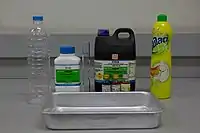Elephant's toothpaste
Elephant's toothpaste is a foamy substance caused by the rapid decomposition of hydrogen peroxide using potassium iodide or yeast and warm water as a catalyst.[1] How rapidly the reaction proceeds will depend on the concentration of hydrogen peroxide.[2][3][4] Because it requires only a small number of ingredients and makes a "volcano of foam", this is a popular experiment for children to perform in school or at parties. The experiment is also known as the "marshmallow experiment", but is unrelated to the psychological Stanford marshmallow experiment.

Explanation
Description
About 50 ml of concentrated (>30%)[5] hydrogen peroxide is first mixed with liquid soap or dishwashing detergent. Then, a catalyst, often around 10 ml potassium iodide solution or catalase from baker's yeast, is added to make the hydrogen peroxide decompose very quickly. Hydrogen peroxide breaks down into oxygen and water. As a small amount of hydrogen peroxide generates a large volume of oxygen, the oxygen quickly pushes out of the container.[6] The soapy water traps the oxygen, creating bubbles, and turns into foam.[6] About 5-10 drops of food colouring could also be added before the catalyst to dramatise the effect. How rapidly the reaction occurs will depend on the concentration of hydrogen peroxide used.[7]
Chemical explanation
This experiment shows the catalysed decomposition of hydrogen peroxide. Hydrogen peroxide (H2O2) decomposes into water and oxygen gas, which is in the form of foam, but normally the reaction is too slow to be easily perceived or measured:[2]
In normal conditions, this reaction takes place very slowly, therefore a catalyst is added to speed up the reaction, which will result in rapid formation of foam. The iodide ion from potassium iodide acts as a catalyst and speeds up the reaction while remaining chemically unchanged in the reaction process.[2][3][8] The iodide ion changes the mechanism by which the reaction occurs:
The reaction is exothermic; the foam produced is hot.[2][3] A glowing splint can be used to show that the gas produced is oxygen.[9] The rate of foam formation measured in volume per time unit has a positive correlation with the peroxide concentration (v/V%), which means that the more reactants (peroxide concentration) the faster the rate of foam formation.[10]

See also
References
- "Elephant Toothpaste". Imagination Station. Archived from the original on 2017-10-28. Retrieved 2017-10-27.
- "Elephant's Toothpaste" (PDF). University of Utah Chemistry Demonstrations. University of Utah. Archived (PDF) from the original on 23 December 2014. Retrieved 21 March 2014.
- "Elephant's Toothpaste - Kid Version". Steve Spangler Science. Archived from the original on 18 March 2014. Retrieved 21 March 2014.
- Dirren, Glen; Gilbert, George; Juergens, Frederick; Page, Philip; Ramette, Richard; Schreiner, Rodney; Scott, Earle; Testen, May; Williams, Lloyd (1983). "Chemical Demonstrations". A Handbook for Teachers of Chemistry. 1: 180–185. Bibcode:1985JChEd..62R..31K. doi:10.1021/ed062pA31.2.
- "Elephant's Toothpaste (slow motion)". Periodic Table of Videos. The University of Nottingham. Archived from the original on 2016-09-28. Retrieved 2016-09-14.
- "The Great Elephant Toothpaste Experiment!". PBS Parents. 2013-10-09. Archived from the original on 2019-04-26. Retrieved 2019-04-26.
- "Elephant Toothpaste: A Hydrogen Peroxide Chemistry Experiment". Using Hydrogen Peroxide. Archived from the original on 2017-10-11. Retrieved 2017-10-19.
- Dirren, Glen; Gilbert, George; Juergens, Frederick; Page, Philip; Ramette, Richard; Schreiner, Rodney; Scott, Earle; Testen, May; Williams, Lloyd (1983). "Chemical Demonstrations". A Handbook for Teachers of Chemistry. 1: 180–185. Bibcode:1985JChEd..62R..31K. doi:10.1021/ed062pA31.2.
- "Catalytic Decomposition of H2O2 – Elephant's Toothpaste" (PDF). NCSU Chemistry Lecture Demonstrations. Archived (PDF) from the original on 2016-01-25. Retrieved 2015-12-06.
- Hernando, Franco; Laperuta, Santiago; Kuijl, Jeanine Van; Laurin, Nihuel; Sacks, Federico; Ciolino, Andrés (2017). "Elephant Toothpaste". Journal of Chemical Education. 94 (7): 907–910. doi:10.1021/acs.jchemed.7b00040.
External links
| Wikimedia Commons has media related to Elephant toothpaste. |
- The Elephant's Toothpaste Experiment sciencebob.com